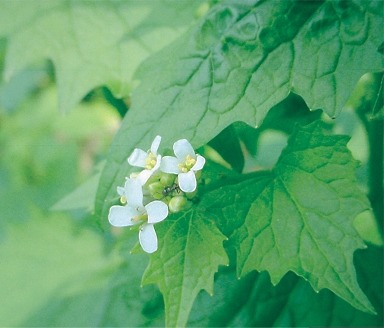- Alliaria petiolata
taxobox
name = Garlic Mustard
regnum =Plantae
unranked_divisio =Angiosperms
unranked_classis =Eudicots
unranked_ordo =Rosids
ordo =Brassicales
familia =Brassicaceae
genus = "Alliaria "
species = "A. petiolata"
binomial = "Alliaria petiolata"
binomial_authority = (M.Bieb.) Cavara & Grande|Garlic mustard ("Alliaria petiolata") is a biennial
flowering plant in the Mustard family,Brassicaceae . It is native toEurope , western and centralAsia , and northwesternAfrica , fromMorocco , Iberia and theBritish Isles , north to northernScandinavia , and east to northernIndia and westernChina (Xinjiang ). First year of growth plants form attractive clumps of round shaped, slightly wrinkled leaves, that when crushed smell like garlic. The next year plants flower in spring, producing cross shaped white flowers in dense clusters, as the flowering stems bloom they elongate into a spike-like shape. When blooming is done, plants produce upright fruits that release seeds in mid summer. Plants are often found growing along the margins ofhedgerow s, giving rise to the old British folk name of "Jack-by-the-hedge". Other common names include "Garlic Root", "Hedge Garlic", "Sauce-alone", "Jack-in-the-bush", "Penny Hedge" and "Poor Man's Mustard". The genus name "Alliaria", "resembling "Allium ", refers to thegarlic -like odour of the crushed foliage.Description
It is a
herbaceous biennial plant (sometimes anannual plant ) growing from a deeply growing, thin, white taproot that is scented like a horse-radish. Plants grow from 30-100 cm (rarely to 130 cm) tall. The leaves are stalked, triangular to heart-shaped, 10-15 cm long (of which about half being the petiole) and 2-6 cm broad, with a coarsely toothed margin. In biennial specimens, first-year plants appear as a rosette of green leaves close to the ground; these rosettes remain green through the winter and develop into mature flowering plants the following spring. Theflower s are produced in spring and summer in button-like clusters. Each small flower has four white petals 4-8 mm long and 2-3 mm broad, arranged in a cross shape. Thefruit is an erect, slender, four-sided pod 2-7 cm long, called asilique , green maturing pale grey-brown, containing two rows of small shiny blackseed s which are released when the pod splits open. Some plants can flower and complete their life-cycle in the first year. A single plant can produce hundreds of seeds, which scatter as much as several meters from the parent plant. Depending upon conditions, garlic mustard flowers either self-fertilize or are cross-pollinated by a variety of insects. Self-fertilized seeds are genetically identical to the parent plant, enhancing its ability to colonize an area where that genotype is suited to thrive. [ [http://www.nps.gov/plants/ALIEN/fact/alpe1.htm PCA Alien Plant Working Group - Garlic Mustard (Alliaria petiolata) ] ] In Europe as many as 69 species ofinsect s and 7 species offungi utilize Garlic Mustard as a food plant, including thelarva e of someLepidoptera species such as theGarden Carpet moth.Cultivation and uses
The leaves, flowers and fruit are edible as
food forhuman s, and are best when young. They have a mild flavour of both garlic and mustard, and are used insalad s andpesto . Once used as medicine.As an invasive species
Garlic mustard was introduced in
North America as a culinary herb in the 1860s and is aninvasive species in much of north America and is listed as a noxious or restricted plant as of 2006 in the US states of Alabama, Connecticut, Massachusetts, Minnesota, New Hampshire, Oregon, Vermont and Washington. [ [http://plants.usda.gov/java/profile?symbol=ALPE4 PLANTS Profile for Alliaria petiolata (garlic mustard) | USDA PLANTS ] ] Unlike most invasive plants, once it has an introduction into a new location, it persists and spreads into undisturbed plant communities. In many areas of its introduction in Eastern North America, it has become the dominant under-story species in woodland and flood plain environments, where eradication is difficult. [Luken, James O., and John W. Thieret. 1997. "Assessment and management of plant invasions". Springer series on environmental management. New York: Springer. ISBN 978-0-387-94809-6 Page 117.]The insects and fungi that feed on it in its native habitat are not present in North America, increasing its seed productivity and allowing it to out-compete native plants. [cite web
url=http://www.michigannature.org/garlicmustard.shtml
publisher=Michigan Nature Association
title=Garlic mustard
accessdate=2007-05-24] Verify credibility|date=July 2007 A study published in 2006 concluded that Garlic Mustard harmsmycorrhizal fungi that some North American plants, including native forest trees, require for proper growth. [cite journal
url=http://biology.plosjournals.org/perlserv/?request=get-document&doi=10.1371/journal.pbio.0040140
title=Invasive Plant Suppresses the Growth of Native Tree Seedlings by Disrupting Belowground Mutualisms
doi=10.1371/journal.pbio.0040140
author=Stinson KA, Campbell SA, Powell JR, Wolfe BE, Callaway RM, et al.
date=2006
journal=PLoS Biology
accessdate=2007-05-24
volume=4
pages=e140] Additionally, becauseWhite-tailed Deer rarely feed on Garlic Mustard, large deer populations may help to increase its population densities by consuming competing native plants. Trampling by browsing deer encourages additional seed growth by disturbing the soil. A complication to the eradication of Garlic Mustard from an area is the longevity of viable seeds in the ground. Seeds contained in the soil can germinate up to five years after being produced. [Garlic Mustard. Plant Conservation Alliance Alien Working Group. Accessed on2007-07-14 . [http://www.nps.gov/plants/alien/fact/alpe1.htm] ]References
External links
* [http://rbg-web2.rbge.org.uk/cgi-bin/nph-readbtree.pl/feout?FAMILY_XREF=&GENUS_XREF=Alliaria+&SPECIES_XREF=petiolata&TAXON_NAME_XREF=&RANK= Flora Europaea: "Alliaria petiolata"]
* [http://www.efloras.org/florataxon.aspx?flora_id=2&taxon_id=200009178 Flora of China: "Alliaria petiolata"]
* [http://www.efloras.org/florataxon.aspx?flora_id=5&taxon_id=200009178 Flora of Pakistan: "Alliaria petiolata"]
* [http://www.pfaf.org/database/plants.php?Alliaria+petiolata Plants for a Future: "Alliaria petiolata"]
* [http://www.patapscoheritagegreenway.org/garlic07/index.html Garlic mustard recipes]
* [http://www.nps.gov/plants/alien/fact/alpe1.htm U.S. NPS guide]
Wikimedia Foundation. 2010.
